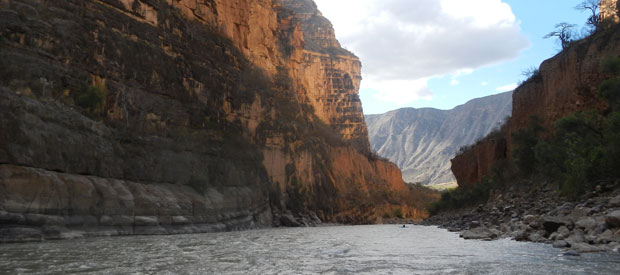The Marañón River is one of the most important water sources in Peru and a key Amazon tributary. With its source at the Nevado de Yapura glacier high up in the Andes mountains, the Marañón runs northwest through Peru along the eastern base of the Andes before it turns eastwards to flow into the Amazon plains. The Marañón meets the Ucayali River and together they form the Amazon River.
The Value of the Marañón
The river runs through 10 distinct regions of Peru. Almost 14% of the Peruvian population lives in these regions, and they include Andean peasants, indigenous Amazon peoples, riparian populations, as well as urban communities. Hundreds of thousands of people depend on the Marañón River for their livelihood.
The Marañón is an area of unique biodiversity, with dry forests that extend along the upper river valley and its tributaries. The region is an area of high bird endemism; there are 64 rare bird species in the Marañón, with 26 of these endemic to Peru.
The Pacaya-Samiria National Reserve, one of the largest in Peru, is located between the Marañón and Ucayali rivers. Animal and plant life is abundant and extremely varied in the reserve. The reserve’s waters are home to gray and pink dolphins, Amazonian manatees, Giant River Otters, Black Caimans and giant South American River Turtles. Land species include Jaguars, Capuchin Monkeys and Spider Monkeys. The Black Spider Monkey, the Orange-chested Spider Monkey, the Woolly Monkey, and the Howler Monkey are all considered endangered.
At least 100,000 “ribereños,” or river people, living in and around this part of the Amazonian rain forest rely on its aquatic and terrestrial resources for food and income. Another 600,000 Peruvians live nearby.
Threats to the Marañón
In late April 2011, former Peruvian President Alan Garcia declared that the construction of 20 dams on the Marañón River was “in the national interest.” The dams are expected to produce 12,430 MW of additional energy for the national grid. Some of the planned dam projects would involve a system of water transfers and irrigation in arid coastal areas. Others are planned to generate electricity to fuel the expansion of mining interests in the Andes, and could be used to export electricity to Brazil.
Eighteen of these proposed dams would be located in sensitive ecosystems such as cloud forests and equatorial seasonally dry forest areas. Locals fear that these dams would severely impact the unique ecosystems in these areas. The dams would flood the lands of indigenous Awajun and Wampis communities, who depend on the river and forest resources. Many are farmers who cultivate cacao, plantain, corn, peanuts and manioc. Their agricultural livelihoods along with fishing in the area would be severely impacted by the proposed projects. Communities would be resettled to unproductive lands or to overcrowded urban centers that lack jobs and basic services.
The harnessing of rivers on the headwaters of the Andean Amazon to provide electricity and secure irrigation for large agricultural enterprises would have a profound effect on the ecology of rivers in this area and their floodplains.
These projects are being proposed in the absence of clear understanding of the ecosystem services these rivers provide, and with very little knowledge about the negative impacts that specific dams would cause.
To date, the rights of dam-threatened communities and indigenous groups have not been addressed and there has been very little consultation in developing the plans.
Our Work to Protect the Marañón
International Rivers is working with partners in the region and internationally to increase the capacity of dam-threatened communities to effectively assert their rights and advocate for the preservation of rivers throughout the Andean Amazon.
Featured image: The River Marañón taken during a reconnaissance raft/kayak trip in July 2012 | Photo by: Rocky Contos

